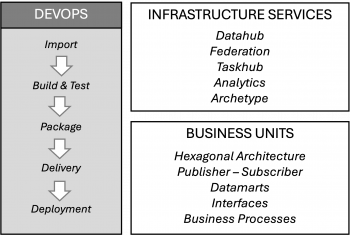Main Page: Difference between revisions
mNo edit summary |
mNo edit summary |
||
| (43 intermediate revisions by the same user not shown) | |||
| Line 1: | Line 1: | ||
== Introduction == | == Introduction == | ||
Intino | Welcome to the Intino Wiki, your comprehensive guide to understanding the architecture, functionality, and operational frameworks of our advanced development platform. It is oriented to provision the demands of modern data-driven enterprises, enhancing their capability to manage and analyze data. | ||
This wiki aims to guide each aspect, offering clarity on the components and their contributions to the overall system. Whether you are a developer, a project manager, or a stakeholder, this wiki will provide you with the insights needed to understand the technical and operational capabilities of Intino. | |||
== What is Intino == | |||
Intino comprises a suite of tools, frameworks, and languages, enabling developers to build, evolve, and maintain [[Intino_Systems|'''Intino Systems''']] around three critical aspects: Infrastructure, Business Units and DevOps. | |||
* '''Infrastructure:''' Discover the core services that form the backbone of Intino, ensuring seamless data management and security across the platform. [[infrastructure|Learn more]]. | |||
* '''Business Units:''' Learn how Intino integrates with business operations, facilitating efficient data processing and decision-making through advanced architectural designs and communication patterns. [[Business_Units|Learn more]]. | |||
* '''DevOps:''' Explore the integration and delivery processes. [[devops|Learn more]]. | |||
[[File:Aspects.png | center | 350px | Aspects.]] | |||
We strive to provide an environment that supports the entire lifecycle of application development—from conception through deployment. Our commitment to excellence and innovation is reflected in every component of this environment, ensuring that developers can build resilient, adaptable, and high-performing systems that are not only fit for today's challenges but also tomorrow's opportunities. | |||
== Benefits == | == Benefits == | ||
Intino is designed to automate and simplify the software development process using Model-Driven Engineering (MDE). | |||
* '''Reduced Development Time and Costs:''' By utilizing Model-Driven Engineering (MDE) and Domain-Specific Languages (DSLs), Intino streamlines the software development process. This automation eliminates repetitive tasks and allows developers to focus on solving domain-specific problems, reducing overall development time and costs. | * '''Reduced Development Time and Costs:''' By utilizing Model-Driven Engineering (MDE) and Domain-Specific Languages (DSLs), Intino streamlines the software development process. This automation eliminates repetitive tasks and allows developers to focus on solving domain-specific problems, reducing overall development time and costs. | ||
* '''Faster Software Evolution and Customization:''' Intino's model-driven approach enables systems to evolve and adapt more quickly. With flexible, reusable components and architecture designed for modularity, developers can tailor solutions to meet changing business requirements or specific customer needs with minimal effort. | * '''Faster Software Evolution and Customization:''' Intino's model-driven approach enables systems to evolve and adapt more quickly. With flexible, reusable components and architecture designed for modularity, developers can tailor solutions to meet changing business requirements or specific customer needs with minimal effort. | ||
| Line 27: | Line 25: | ||
== Getting Started == | == Getting Started == | ||
Ready to begin with Intino? Follow our [[ | Ready to begin with Intino? Follow our [[Getting_Started_Guide|Getting Started Guide]] to set up your development environment and create your first project. | ||
Latest revision as of 17:22, 14 May 2024
Introduction
Welcome to the Intino Wiki, your comprehensive guide to understanding the architecture, functionality, and operational frameworks of our advanced development platform. It is oriented to provision the demands of modern data-driven enterprises, enhancing their capability to manage and analyze data.
This wiki aims to guide each aspect, offering clarity on the components and their contributions to the overall system. Whether you are a developer, a project manager, or a stakeholder, this wiki will provide you with the insights needed to understand the technical and operational capabilities of Intino.
What is Intino
Intino comprises a suite of tools, frameworks, and languages, enabling developers to build, evolve, and maintain Intino Systems around three critical aspects: Infrastructure, Business Units and DevOps.
- Infrastructure: Discover the core services that form the backbone of Intino, ensuring seamless data management and security across the platform. Learn more.
- Business Units: Learn how Intino integrates with business operations, facilitating efficient data processing and decision-making through advanced architectural designs and communication patterns. Learn more.
- DevOps: Explore the integration and delivery processes. Learn more.

We strive to provide an environment that supports the entire lifecycle of application development—from conception through deployment. Our commitment to excellence and innovation is reflected in every component of this environment, ensuring that developers can build resilient, adaptable, and high-performing systems that are not only fit for today's challenges but also tomorrow's opportunities.
Benefits
Intino is designed to automate and simplify the software development process using Model-Driven Engineering (MDE).
- Reduced Development Time and Costs: By utilizing Model-Driven Engineering (MDE) and Domain-Specific Languages (DSLs), Intino streamlines the software development process. This automation eliminates repetitive tasks and allows developers to focus on solving domain-specific problems, reducing overall development time and costs.
- Faster Software Evolution and Customization: Intino's model-driven approach enables systems to evolve and adapt more quickly. With flexible, reusable components and architecture designed for modularity, developers can tailor solutions to meet changing business requirements or specific customer needs with minimal effort.
- Higher Quality Products Tailored to Specific User Needs: The use of DSLs ensures that the software directly addresses the specialized needs of a given domain, resulting in fewer bugs and inconsistencies. The platform’s architecture also promotes consistent development practices, which improve overall product quality. This allows developers to deliver software that aligns more closely with customer expectations.
Getting Started
Ready to begin with Intino? Follow our Getting Started Guide to set up your development environment and create your first project.